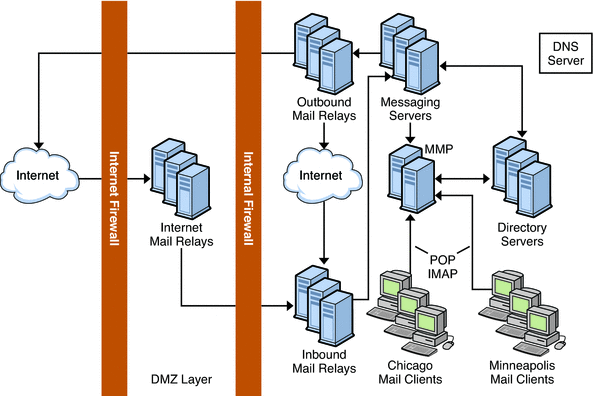Creating a Messaging Topology Example
Once you have a basic understanding of your topological needs, your strategy, and the topology elements, you can create your messaging topology. To illustrate how to create a messaging topology, this section uses the example of the Siroe Corporation.
The Siroe Corporation is a multimedia organization headquartered in New York, with two smaller offices in Los Angeles and Chicago, and two satellite offices in San Diego and in Minneapolis.
Step 1: Identifying Messaging Goals
The first step in creating a topology is to understand the goals of your organization. Similar to Chapter 2, Analyzing Your Communications Suite Requirements, Siroe’s messaging goals can be categorized into business objectives, technical, and financial constraints.
Siroe’s Business Objectives
The finance, marketing, legal, IT, and engineering groups are located in New York. The creative groups are located in Los Angeles and in San Diego. The technical support groups are located in Chicago and Minneapolis. Most messages are sent between Chicago, Los Angeles, and New York.
Employees at the Siroe Corporation rely on email as their primary method of communication. On average, employees send approximately 15 messages per day with attachments in the form of spreadsheets, presentations, or animation.
The deployment planners determined that Message Server hosts would be set up in Chicago, Los Angeles, and in New York. Since the volume of email traffic in San Diego and in Minneapolis is relatively light, these satellite offices will only have mail clients connecting to servers that are located in Chicago and in Los Angeles.
Siroe’s Financial and Technical Constraints
Because of budgetary restrictions, Siroe will be using the existing infrastructure and hardware that is already in place, moving servers to locations where there is critical need. 24x7 support will be available only in the New York, Chicago, and Los Angeles offices. All offices will be connected by T3 lines to the Internet.
Step 2: Choosing a Topology Strategy
The second step in creating your messaging topology is to choose your topology strategy, described in Designing a Messaging Topology. The Siroe Corporation evaluated their business objectives as well as their financial and technical constraints. They determined that:
-
Messaging Server hosts did not need to be deployed at satellite sites, only mail clients.
-
Good bandwidth exists at satellite sites (T3 lines).
-
Regardless of location, mail users send and receive large messages throughout the corporation.
-
There are large user populations in New York, Los Angeles, and Chicago, but not in Minneapolis or San Diego.
-
Support personnel exist in New York, Los Angeles, and in Chicago.
The Siroe Corporation then mapped their objectives and constraints to a common design strategy. Figure 12–7 shows that the Siroe Corporation has chosen a hybrid topology.
Figure 12–7 Hybrid Topology for the Siroe Corporation

Because New York has the highest message transaction rate of messages entering and leaving the system, it has the most number of messaging servers. The smaller offices, Los Angeles and Chicago, also support San Diego and Minneapolis. However, these satellite offices do not require their own messaging servers. Instead, Chicago and Los Angeles act as the central location for their services.
Step 3: Planning the Topology Elements
The final step in creating your messaging topology is to plan your topology elements in your actual deployment, as described in Understanding Messaging Topology Elements. The following figure illustrates the topology elements in the Chicago and Minneapolis offices.
Figure 12–8 Topological Elements in the Siroe Messaging Deployment for Chicago and Minneapolis

Because 30 percent of the workforce is made up of third-party vendors and contractors, internal firewalls are used in addition to the external firewalls in the topology to restrict access to locations within the company. Internet MTAs are placed in the topology to route messages from the Internet and relay them across the firewall. MTAs are added to route incoming and outgoing messages. Separating incoming and outgoing messages helps to manage the high volume of message traffic. The MMP connects employees’ POP and IMAP mail clients to their mailboxes in the Messaging Servers. By using an MMP, employees don’t have to know their specific mail host when they log in, and administrators can seamlessly move employees’ mailboxes to different mail server locations.
Creating a messaging topology enables you to account for the physical and logical placement of all the elements in your deployment. Doing so ensures minimal rework of your installation.
- © 2010, Oracle Corporation and/or its affiliates
